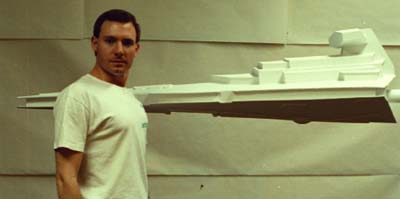
The Star Wars trilogy are my favorite movies and I have always been especially impressed with the Star Destroyers. I've wanted to build a model of this ship since I was a kid but I didn't know how they had constructed the original model and to this day I have not been able to find any accurate blueprints of the ship. Plus, for many years I wasn't able find any good pictures of the ship from the angles I needed to come up with my own blueprints. But in the last seven or eight years and especially in the last two years I have started coming across a lot more pictures of the ship from various angles and even some interior views of the model. In fact, by 1991 I had come across enough pictures from various angles that I felt that I could probably build a very accurate Star Destroyer model myself.
So in 1992, I spent about six months creating the 3D blueprints for a 5' 3" Star Destroyer model using Intergraph's MicroStation CAD software. At the end of this process I also decided that I needed to physically see how big this model really was so I then spent about another three months creating a full sized cardboard prototype version of the model. Below is a picture of the 5' 3" model.

Unfortunately, after I had completed the blueprints I discovered what I thought at the time to be a small "flaw" in this design. I had designed the main wedge shaped body of the ship in the side view to be symmetrical around an axis running through the center of that part. See the above picture. But after looking at several pictures I had of the original 8.5 foot model on stage, those pictures clearly showed that the model's top edge was horizontal. The only problem was that correcting the flaw would mean redrawing every line in the entire design!
At this time I thought my design was wrong, but in April 1998 after I was able to photograph the original 8.5 foot model, I discovered that the real model was also designed like my original design. My confusion about this issue resulted from the fact that in TESB and ROTJ they filmed the 8.5 foot model as though the top edge of the wedge section of the ship was horizontal even though it wasn't. I think what happened was that after the model was built somebody said, "Hey you know, this model looks better if we tilt its nose up when we film it". And so when the effects crew were about to film the model, they would physically tilt its nose up until the top edge was horizontal. This can be seen in the side view of the blueprints by clicking here.
Well after much thought, I decided back in 1992 that I would save what I had learned and redo the design again once I had my own copy of MicroStation for my Mac. For about the next four years the project was put on hold, although I continued to a enhance my collection of photographs of the model. Then in 1996, a number of things had come together to put me in a position that I could now start the design again from the beginning.
First, I had recently got ahold of a number of really great photographs of the model that would help me increase the accuracy of the resulting design. Plus, my home computer now had MicroStation and enough memory to allow it to run very comfortably. So from September 1996 to June 1997, I created the second set of blueprints for my Star Destroyer model, this time with its top edge horizontal.
What results from all my confusion over how the real model was designed and built as opposed to how the effects crews filmed the model, is that my 6' model will be slightly geometrically different from the real 8.5' model. If you were to put the real Star Destroyer model up next to my model you would notice that the nose of my model will stick up higher than the nose of the real model. Is this a design flaw in my model? It depends on how you look at it. My latest model's design is incorrect with respect to the actual model, but it is correct with respect to how ILM filmed the real model. Personally, I think the model looks best with its top edge horizontal. Apparently ILM did as well because that's how they filmed it.